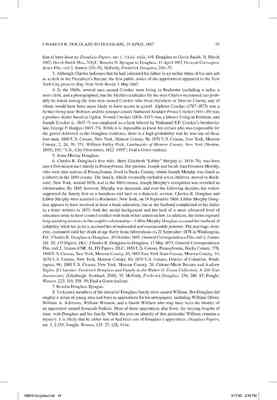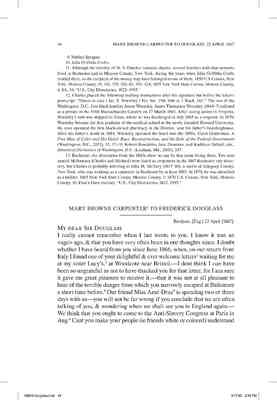Pages
page_0001
CHARLES R. DOUGLASS1Charles Remond Douglass (1844–1920), named after the abolitionist Charles Remond, was the youngest of Frederick and Anna Murray Douglass’s sons. He was born in Lynn, Massachusetts, and, like his brothers, was both educated in Rochester and trained by his father in the newspaper office. Like Lewis H. Douglass, Charles enlisted in the Fifty-fourth Massachusetts Infantry during the Civil War, but mainly served with the Fifth Massachusetts Cavalry Regiment, where he was promoted to the rank of first sergeant. After the war, Charles settled in Washington, D.C., and found employment first as a clerk in the Freedmen’s Bureau (1867–69) and later in the Treasury Department (1869–75). After his father purchased the New National Era in 1870, Charles acted as a correspondent for the newspaper. In 1871 he served as a clerk to the Santo Domingo Commission, and President Ulysses S. Grant later appointed him consul to Puerto Plata, Santo Domingo. From 1875 to 1879 he was a clerk in the U.S. consulate in Santo Domingo. Returning to the United States in 1879, he entered the West Indies import-export business while living in Corona, New York. In 1882, Charles moved back to Washington, D.C., and took a job as an examiner in the Pension Bureau. He remained there until 1892, when he entered the real estate business. Douglass Papers, ser. 2, 3:860; Douglass Papers, ser. 3, 1:126; McFeely, Frederick Douglass, 239, 257–58, 272; EAAH, 1: 407–08. TO FREDERICK DOUGLASS Rochester, [N.Y.] 19 Ap[ri]l [18]67.
DEAR FATHER
I have just rec[eive]d. your letter from Layfaette Ind. I am sorry you failed to connect at Mechanicsville2Douglass spent most of the winter of 1866–67 on an extended lecture tour that took him as far west as Iowa, with stops in major cities such as Pittsburgh, St. Louis, Chicago, and Indianapolis, before returning home near the end of March. Within days of his arrival in Rochester, however, he wrote Gerrit Smith that he was preparing to leave for another five to six-week lecture tour of the same region. Correspondence with his daughter indicates that Douglass was expected to pass through Pittsburgh and Zanesville, Ohio, before 11 April, and newspaper accounts place Douglass in Michigan on 26 April, so while the editors cannot confirm that Douglass either spoke at, or even passed through, Lafayette, Indiana, and Mechanicsville, Iowa, his known schedule certainly left room for him to have done so. Douglass Papers, ser. 1, 4: xxii–xxiii, 149; Douglass to Gerrit Smith, 31 March 1867, Gerrit Smith Mss., NSyU; Rosetta D. Sprague to Douglass, 11 April 1867, General Correspondence File, reel 2, frames 250–52; McFeely, Frederick Douglass, 256–57. for I wrote to you at that place telling you of my appointment as clerk in the Freedman’s Bureau.3Although Charles indicates that he had informed his father in an earlier letter of his new job as a clerk in the Freedmen’s Bureau, the first public notice of the appointment appeared in the New York City press in May. New York World, 1 May 1867. I wrote to you for a little money but I shall have to leave without it as I don’t want to lose my situation by waiting after having been sent for. The gravel has been drawn on the road in front by Mr. Crocker4In the 1860s, several men named Crocker were living in Rochester (including a tailor, a store clerk, and a photographer), but the likelier candidates for the man Charles mentioned can probably be found among the four men named Crocker who lived elsewhere in Monroe County, any of whom would have been more likely to have access to gravel. Alpheus Crocker (1787–1873) was a farmer living near Webster, and his younger cousin Nathaniel Scudder Prince Crocker (1814–89) was a produce dealer based in Ogden. Newall Crocker (1836–1917) was a laborer living in Perinton, and Joseph Crocker (c. 1847–?) was employed as a farm laborer by Nathaniel S.P. Crocker’s brother-inlaw, George P. Hodges (1807–73). While it is impossible to know for certain who was responsible for the gravel delivered to the Douglass residence, there is a high probability that he was one of these four men. 1860 U.S. Census, New York, Monroe County, 56; 1870 U.S. Census, New York, Monroe County, 2, 28, 39, 374; William Farley Peck, Landmarks of Monroe County, New York (Boston, 1895), 103; “U.S., City Directories, 1822–1995”; Find a Grave (online). whose charge will be $20 the amount you subscribed provided the road should be graveled to the city line. In addition to this he will draw about ten loads inside the lot for the road leading from the gate, and will also plow the lot. I have left everything as well as I could under the circumstances[.] I don’t want to stay here too
page_0002
long for fear of losing my situation. Mother5Anna Murray Douglass. is sick[.] She had a billious attack to day and had to take her bed and summon a doctor[.] She is some better now and says for me not to delay on her account. Libbie6Charles R. Douglass’s first wife, Mary Elizabeth “Libbie” Murphy (c. 1848–78), was born into a free mixed-race family in Pennsylvania. Her parents, Joseph and Sarah Ann Freeman Murphy, who were also natives of Pennsylvania, lived in Bucks County, where Joseph Murphy was listed as a laborer in the 1850 census. The family, which eventually included seven children, moved to Rochester, New York, around 1858, and in the 1860 census, Joseph Murphy’s occupation was recorded as whitewasher. By 1865, however, Murphy was deceased, and over the following decades, his widow supported the family first as a laundress and later as a domestic servant. Charles R. Douglass and Libbie Murphy were married in Rochester, New York, on 19 September 1866. Libbie Murphy Douglass appears to have received at least a basic education, but as her husband complained to his father in a letter written in 1873, both her social background and her lack of a more advanced level of education seem to have created conflict with both of her sisters-in-law. In addition, the letter exposed long-standing tensions in the couple’s relationship—Libbie Murphy Douglass accused her husband of infidelity, while he, in turn, accused her of unfounded and unreasonable jealousy. The marriage, however, continued until her death at age thirty from tuberculosis on 21 September 1878 in Washington, D.C. Charles R. Douglass to Douglass, 29 October 1865, General Correspondence File, reel 2, frames 161–62, FD Papers, DLC; Charles R. Douglass to Douglass, 13 May 1873, General Correspondence File, reel 2, frames 678R–81, FD Papers, DLC; 1850 U.S. Census, Pennsylvania, Bucks County, 378; 1860 U.S. Census, New York, Monroe County, 20; 1865 New York State Census, Monroe County, 34; 1870 U.S. Census, New York, Monroe County, 80; 1870 U.S. Census, District of Columbia, Washington, 96; 1880 U.S. Census, New York, Monroe County, 26; Celeste-Marie Bernier and Andrew Taylor, If I Survive: Frederick Douglass and Family in the Walter O. Evans Collection: A 200 Year Anniversary (Edinburgh, Scotland, 2018), 35; McFeely, Frederick Douglass, 256, 286–87; Fought, Women, 223, 310, 358–59; Find a Grave (online). will stay with her until you return, she will then go and board with Rosetta7Rosetta Douglass Sprague. until I can find accommodations for her in Washington. William8No known members of the extended Douglass family were named William. But Douglass did employ a series of young men and boys as apprentices for his newspapers, including William Oliver, William A. Atkinson, William Winston, and a fourth William who may have been the brother of an apprentice named Jeremiah Perkins. Most of these apprentices also lived, for varying lengths of time, with Douglass and his family. While the precise identity of this particular William remains a mystery, it is likely that he either was or had been one of Douglass’s apprentices. Douglass Papers, ser. 3, 2: 253; Fought, Women, 125–25, 128, 344n. is home now and is having his spring vacation of two weeks during that time and until you come home he will work the garden. I will leave the care of your letters with Rosetta with the same instructions that you gave me. If you are to stay away longer than you expected it would be well to send Nathan9Nathan Sprague. enough money to provide for the cow and horse until you come. I am all in a bristle, owing to my appointment coming so unexpectedly and just at the time I was making every preparation to stay here. I sent the money from Mrs. Crofts10Julia Griffiths Crofts. to Mr M. V. Dutcher11Although the identity of M. V. Dutcher remains elusive, several families with that surname lived in Rochester and in Monroe County, New York, during the years when Julia Griffiths Crofts resided there, so the recipient of the money may have belonged to one of them. 1850 U.S Census, New York, Monroe County, 91, 161, 170, 382–83, 394, 424; 1855 New York State Census, Monroe County, 4, 8A, 34; “U.S., City Directories, 1822–1995.” and have rec[eive]d. an acknowledgement of the same and forwarded it on to Mrs. Crofts.
I will write again from Washington[.]
CHAS. R. DOUG LASS12Charles placed the following mailing instructions after his signature but before the letter’s postscript: “Direct in care / Jas. T. Wormley / Fer. bet. 15th 16th st. / Wash. D.C.” The son of the Washington, D.C., free black hotelier James Wormley, James Thompson Wormley (1844–?) enlisted as a private in the Fifth Massachusetts Cavalry on 17 March 1864. After seeing action in Virginia, Wormley’s unit was shipped to Texas, where he was discharged in July 1865 as a sergeant. In 1870, Wormley became the first graduate of the medical school at the newly founded Howard University. He soon operated the first black-owned pharmacy in the District, near his father’s boardinghouse. After his father’s death in 1884, Wormley operated the hotel into the 1890s. Carol Gelderman, A Free Man of Color and His Hotel: Race, Reconstruction, and the Role of the Federal Government (Washington, D.C., 2012), 12, 17–19; Robert Benedetto, Jane Donovan, and Kathleen DuVall, eds., Historical Dictionary of Washington, D.C. (Lanham, Md., 2003), 247.
P.S. I have rented the house at two dollars per week to the carpenter Mcnara13Rochester city directories from the 1860s show no one by that name living there. Two men named McNamara (Charles and Michael) were listed as carpenters in the 1867 Rochester city directory, but Charles is probably referring to John M. McNary (1837–80), a native of Allegany County, New York, who was working as a carpenter in Rochester by at least 1865. In 1870, he was identified as a builder. 1865 New York State Census, Monroe County, 3; 1870 U.S. Census, New York, Monroe County, 16; Find a Gave (online); “U.S., City Directories, 1822–1995.”
ALS: General Correspondence File, reel 2, frames 253–54, FD Papers, DL



